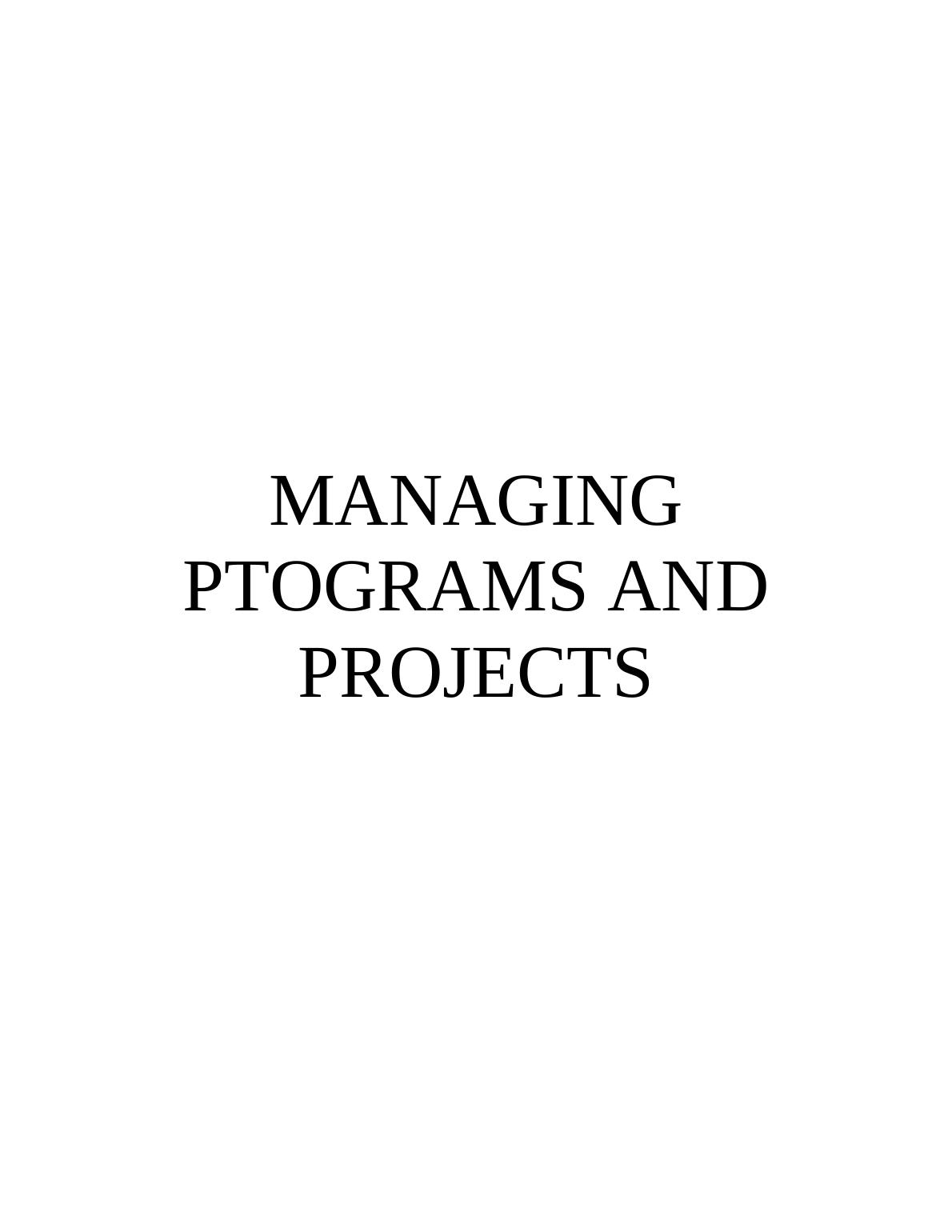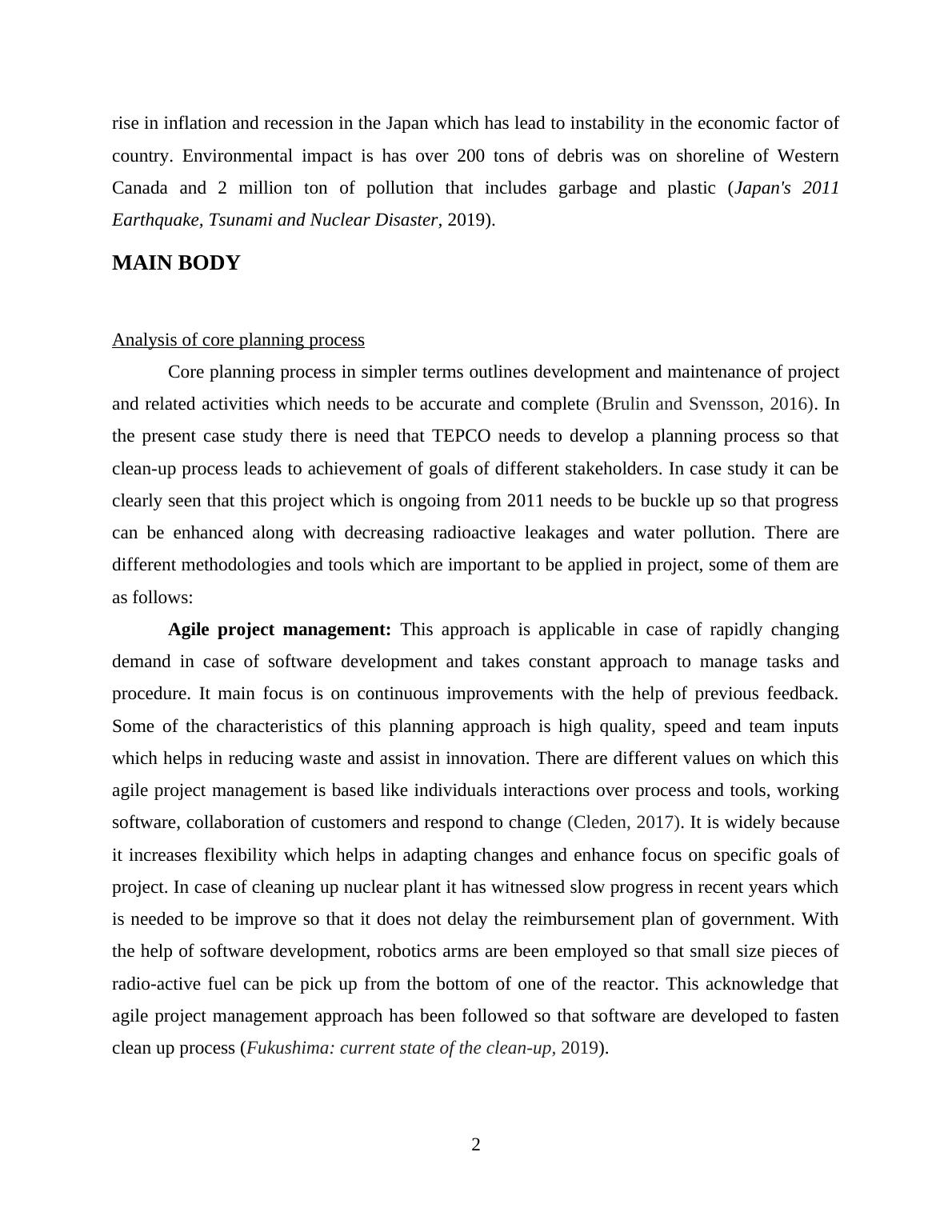Managing Programs and Projects
Added on 2023-01-17
14 Pages4461 Words64 Views
MANAGING
PTOGRAMS AND
PROJECTS
PTOGRAMS AND
PROJECTS

Table of Contents
INTRODUCTION...........................................................................................................................1
MAIN BODY...................................................................................................................................2
Analysis of core planning process...............................................................................................2
Simulation...................................................................................................................................4
Project Planning Approaches......................................................................................................7
CONCLUSION................................................................................................................................9
REFERENCES..............................................................................................................................11
INTRODUCTION...........................................................................................................................1
MAIN BODY...................................................................................................................................2
Analysis of core planning process...............................................................................................2
Simulation...................................................................................................................................4
Project Planning Approaches......................................................................................................7
CONCLUSION................................................................................................................................9
REFERENCES..............................................................................................................................11

INTRODUCTION
Project is defined as task with has beginning and ending and thus have some scope and
utilise resources. It is not routine activity but specified operations which are design in order to
achieve organisational objectives. Project management is the process of applying skills,
techniques, tools and knowledge for completing project and meeting requirements. There are
different criteria that are constraint to some time period and budgets and are evaluated at the time
of deliverance (Badewi, 2016). This project will include case study of 2011 earthquake and
tsunami in Japan due to which Fukushima Daiichi reactors melted down. There were 11 such
reactors in 4 different nuclear power plants which was damaged by tsunami and lead to
malfunction in cooling and circulation of water. After that more than 1,00,000 individuals were
evacuated so that further damage can be controlled which is affecting 1800 square kilometres of
land with variations in radiations (Eight years on, water woes threaten Fukushima cleanup,
2019). TEPCO is Tokyo Electric Power Company Holding Inc. is largest power company of
Japan which includes Fuel and Power Inc., Power Grid Inc. and Energy Partner Inc. It generates,
sells, distributes electricity and other sources of energy in Tokyo and Yokohama. More than 41,
525 employees are working to provide safe, reliable and fulfilling responsibilities to individuals
and communities of Fukushima (About TEPCO, 2019).
There are different stakeholders like TEPCO which is owner of plant at the time of
natural calamity and its main focus is to focus on monetary expenses on clean-up procedure,
legal actions, responsibilities and taking control again. Another is Japanese Government which
has taken partial control and main objective is to regulate future nuclear reforms, reimburse
citizens and cost of cleaning process. General Public are also stakeholders as their objective is to
get safety, regain lost property, regulatory reform in nuclear energy. There are different
industries like fishing, agriculture and nuclear energy which has main objective is to limit the
radioactive and contaminated water from leaking into ocean that affect water, land and air. There
are different impact of this disaster, Political Impact is in future there will be many obstacles to
restart nuclear power plants which has been shut down and there is going to be regulations
reforms for such nuclear energy (Bass, 2016). In this disaster the main impact was on social
aspects as many local communities were evacuated from danger zone which leads to
displacements from society. Next impact is on economy, this disaster in resulting in destruction
of £1.92 billion and lost of over 6,000 lives. Others were high imports, decline in growth rate,
1
Project is defined as task with has beginning and ending and thus have some scope and
utilise resources. It is not routine activity but specified operations which are design in order to
achieve organisational objectives. Project management is the process of applying skills,
techniques, tools and knowledge for completing project and meeting requirements. There are
different criteria that are constraint to some time period and budgets and are evaluated at the time
of deliverance (Badewi, 2016). This project will include case study of 2011 earthquake and
tsunami in Japan due to which Fukushima Daiichi reactors melted down. There were 11 such
reactors in 4 different nuclear power plants which was damaged by tsunami and lead to
malfunction in cooling and circulation of water. After that more than 1,00,000 individuals were
evacuated so that further damage can be controlled which is affecting 1800 square kilometres of
land with variations in radiations (Eight years on, water woes threaten Fukushima cleanup,
2019). TEPCO is Tokyo Electric Power Company Holding Inc. is largest power company of
Japan which includes Fuel and Power Inc., Power Grid Inc. and Energy Partner Inc. It generates,
sells, distributes electricity and other sources of energy in Tokyo and Yokohama. More than 41,
525 employees are working to provide safe, reliable and fulfilling responsibilities to individuals
and communities of Fukushima (About TEPCO, 2019).
There are different stakeholders like TEPCO which is owner of plant at the time of
natural calamity and its main focus is to focus on monetary expenses on clean-up procedure,
legal actions, responsibilities and taking control again. Another is Japanese Government which
has taken partial control and main objective is to regulate future nuclear reforms, reimburse
citizens and cost of cleaning process. General Public are also stakeholders as their objective is to
get safety, regain lost property, regulatory reform in nuclear energy. There are different
industries like fishing, agriculture and nuclear energy which has main objective is to limit the
radioactive and contaminated water from leaking into ocean that affect water, land and air. There
are different impact of this disaster, Political Impact is in future there will be many obstacles to
restart nuclear power plants which has been shut down and there is going to be regulations
reforms for such nuclear energy (Bass, 2016). In this disaster the main impact was on social
aspects as many local communities were evacuated from danger zone which leads to
displacements from society. Next impact is on economy, this disaster in resulting in destruction
of £1.92 billion and lost of over 6,000 lives. Others were high imports, decline in growth rate,
1

rise in inflation and recession in the Japan which has lead to instability in the economic factor of
country. Environmental impact is has over 200 tons of debris was on shoreline of Western
Canada and 2 million ton of pollution that includes garbage and plastic (Japan's 2011
Earthquake, Tsunami and Nuclear Disaster, 2019).
MAIN BODY
Analysis of core planning process
Core planning process in simpler terms outlines development and maintenance of project
and related activities which needs to be accurate and complete (Brulin and Svensson, 2016). In
the present case study there is need that TEPCO needs to develop a planning process so that
clean-up process leads to achievement of goals of different stakeholders. In case study it can be
clearly seen that this project which is ongoing from 2011 needs to be buckle up so that progress
can be enhanced along with decreasing radioactive leakages and water pollution. There are
different methodologies and tools which are important to be applied in project, some of them are
as follows:
Agile project management: This approach is applicable in case of rapidly changing
demand in case of software development and takes constant approach to manage tasks and
procedure. It main focus is on continuous improvements with the help of previous feedback.
Some of the characteristics of this planning approach is high quality, speed and team inputs
which helps in reducing waste and assist in innovation. There are different values on which this
agile project management is based like individuals interactions over process and tools, working
software, collaboration of customers and respond to change (Cleden, 2017). It is widely because
it increases flexibility which helps in adapting changes and enhance focus on specific goals of
project. In case of cleaning up nuclear plant it has witnessed slow progress in recent years which
is needed to be improve so that it does not delay the reimbursement plan of government. With
the help of software development, robotics arms are been employed so that small size pieces of
radio-active fuel can be pick up from the bottom of one of the reactor. This acknowledge that
agile project management approach has been followed so that software are developed to fasten
clean up process (Fukushima: current state of the clean-up, 2019).
2
country. Environmental impact is has over 200 tons of debris was on shoreline of Western
Canada and 2 million ton of pollution that includes garbage and plastic (Japan's 2011
Earthquake, Tsunami and Nuclear Disaster, 2019).
MAIN BODY
Analysis of core planning process
Core planning process in simpler terms outlines development and maintenance of project
and related activities which needs to be accurate and complete (Brulin and Svensson, 2016). In
the present case study there is need that TEPCO needs to develop a planning process so that
clean-up process leads to achievement of goals of different stakeholders. In case study it can be
clearly seen that this project which is ongoing from 2011 needs to be buckle up so that progress
can be enhanced along with decreasing radioactive leakages and water pollution. There are
different methodologies and tools which are important to be applied in project, some of them are
as follows:
Agile project management: This approach is applicable in case of rapidly changing
demand in case of software development and takes constant approach to manage tasks and
procedure. It main focus is on continuous improvements with the help of previous feedback.
Some of the characteristics of this planning approach is high quality, speed and team inputs
which helps in reducing waste and assist in innovation. There are different values on which this
agile project management is based like individuals interactions over process and tools, working
software, collaboration of customers and respond to change (Cleden, 2017). It is widely because
it increases flexibility which helps in adapting changes and enhance focus on specific goals of
project. In case of cleaning up nuclear plant it has witnessed slow progress in recent years which
is needed to be improve so that it does not delay the reimbursement plan of government. With
the help of software development, robotics arms are been employed so that small size pieces of
radio-active fuel can be pick up from the bottom of one of the reactor. This acknowledge that
agile project management approach has been followed so that software are developed to fasten
clean up process (Fukushima: current state of the clean-up, 2019).
2

End of preview
Want to access all the pages? Upload your documents or become a member.
Related Documents
Business Risk Management: Analysis of Fukushima Nuclear Disasterlg...
|14
|4747
|228
The Earthquake and Tsunami in Japan in 2011lg...
|4
|1097
|39
Surveillance and Disaster Management: Lessons from Earthquake and Tsunami in Japanlg...
|3
|579
|493
Assignment on Consulting Projectlg...
|11
|3550
|38
Public Relations Theories (pdf)lg...
|17
|4378
|17
HI5003 - Economics for Business - Assignmentlg...
|5
|1349
|49
